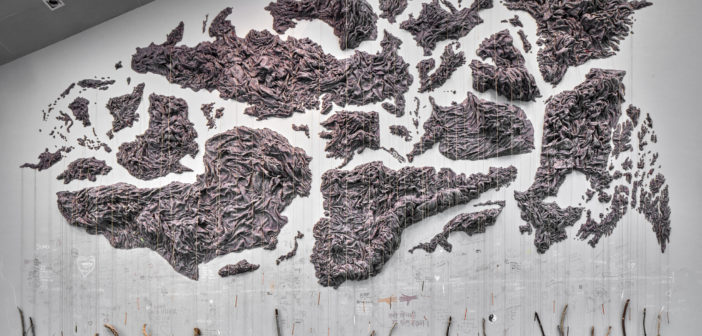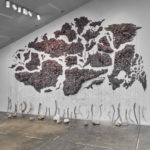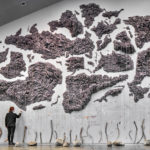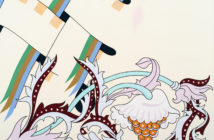Brooklyn-based artist Wangechi Mutu’s installation A Promise To Communicate, now on view at the Institute of Contemporary Art, Boston, addresses complex issues regarding methodologies of communication, as well as the abstract, often arbitrary systems within which the body exists. Repurposing humanitarian aid rescue blankets as her primary material, Mutu has created a large-scale map that covers the museum’s Sandra and Gerald Fineberg Art Wall. Shaped to suggest continental land masses, the molded blankets given to refugees in camps also allude to the absent human body, a haunting reminder off all the bodies that are ignored when they are not right in front of the viewer. Human absence is a tool that Mutu utilizes to communicate the concerns of these neglected people. Through their literal absence, their metaphorical presence in the space becomes amplified.
Born in Nairobi, Kenya, in 1972, Mutu is best known for her site-responsive installations that combine sculptural, drawn, and painted elements. Directly responding to the architectural spaces in which her pieces exist, Mutu’s work is concerned with issues of feminism, sexuality, ecology, displacement, and politics. She coined the term “maximalist aesthetic” to describe her own work because of its dynamic culmination of forms and compositions. In A Promise to Communicate, Mutu addresses the need for public engagement and exchange, embracing the possibilities that arise from collaborative efforts and collective visions.
The countries in this installation loosely refer to an actual map, taking on the form of an imagined topography. Through a fictional geographical representation, Mutu redirects the viewer’s focus from recognizable, distinct locations to the content of the work. In this distortion, the discomfort of not knowing is what draws the viewer closer to the work, to further examine and attempt to discern. The viewer finds herself positioned in front of the blankets, eliciting consideration of her own relationship to the refugee crisis. And from this place of thought, it can be seen that the topography is representative of one world, a shared space.
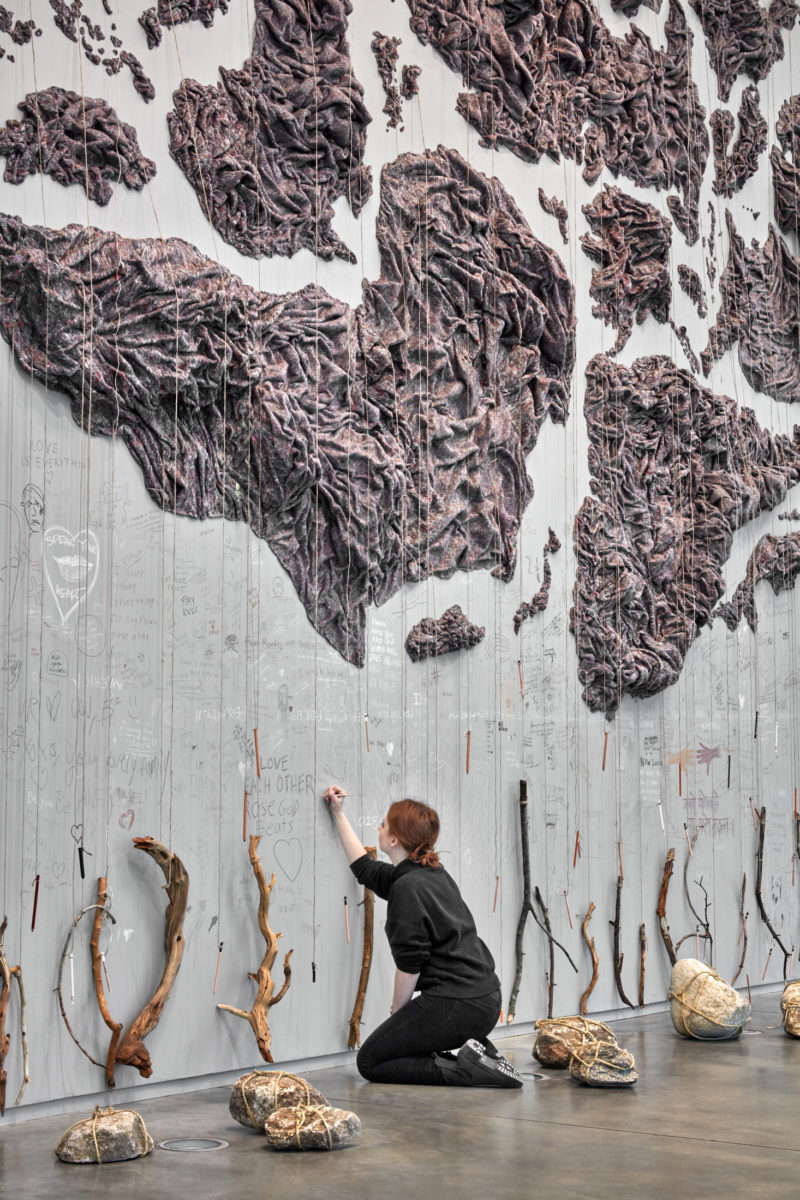
Wangechi Mutu, "A Promise To Communicate," 2017. Installation view, The Institute of Contemporary Arts/Boston, 2017. Photo by Charles Mayer Photography. © Wangechi Mutu
The negative space devoid of blanket leaves the wall to represent the dividing waters. In addition, there are writing tools afixed to strings suspended from the gallery wall, allowing viewers to interact with the work and add their own written response to the piece. Beginning as a blank space, the waters gradually fill with a dense network of interwoven text, letters, and symbols, accumulating over the course of the exhibition to create an intricate patterning. In this way, the piece is always changing as it is shifted by the responses of the public.
Mutu explains that her aim was for the work to permit a space where ideas could be expressed and explored, through a universal communication method such as art. The ICA’s press release states: “Titled A Promise to Communicate, the work will also create a space for visitors to explore ideas of public space, communication, and free speech, addressing the idea of a world that despite its increasing potential for collectivity struggles to communicate in a comprehensive way.” (1) The monumental scale of this installation encourages viewers to reconsider their personal relationship to an international problem. There always persists a shared connection between humans and countries on a global scale. What is accomplished through collaboration and exchange of ideas is always greater than what is achieved as an individual. What Mutu is suggesting here, by inviting visitors to insert their voice and ideas into the work, is that the conversation between art and audience, between individuals and the global community, is open and fluid. We are variables that can contribute to shaping the future—first through dialogue, then through actions. The timeliness of such considerations in A Promise to Communicate speaks to the urgent need for individuals to come together and open up a space where dialogue and change can occur.
For more information on the exhibition, including hours of operation, special programming and accessibility, among others, please refer to: https://www.icaboston.org/exhibitions/wangechi-mutu-promise-communicate
Citations:
(1) https://www.icaboston.org/exhibitions/wangechi-mutu-promise-communicate
- Wangechi Mutu, “A Promise To Communicate,” 2017. Installation view, The Institute of Contemporary Arts/Boston, 2017. Photo by Charles Mayer Photography. © Wangechi Mutu
- Wangechi Mutu, “A Promise To Communicate,” 2017. Installation view, The Institute of Contemporary Arts/Boston, 2017. Photo by Charles Mayer Photography. © Wangechi Mutu
- Wangechi Mutu, “A Promise To Communicate,” 2017. Installation view, The Institute of Contemporary Arts/Boston, 2017. Photo by Charles Mayer Photography. © Wangechi Mutu

